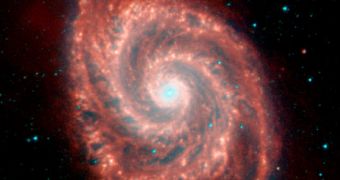Scientists operating the Infrared Array Camera (IRAC) instrument aboard the American space agency's Spitzer Space Telescope announce the completion of an 1,000-day survey of the infrared Universe.
The endeavor produced an amazing series of images of various unusual structures, including a young star cluster, the young and distant Cosmos, a space tornado, the Milky Way, Sombrero and Whirlpool galaxies, and the famous “Mountains of Creation.”
The purpose of the new survey was to analyze the Universe at infrared wavelengths in a complete, thorough manner. This meant studying everything from the Sun's neighborhood to the most distant objects that Spitzer's warming instruments could see.
The “warm” program began after the telescope exhausted all of its liquid helium coolant. The substance was being used to keep its light detectors at temperatures near absolute zero, which in turn enabled the observatory to see all objects in the Universe that were warmer than that.
Experts at the Harvard-Smithsonian Center for Astrophysics (CfA) played an important role in this research effort, since they were part of the team that handled the IRAC data. To mark the 1,000-day milestone, they have recently released a 10-image gallery of the most beautiful IR images.
“IRAC continues to be an amazing camera, still producing important discoveries and spectacular new images of the infrared universe,” CfA expert and IRAC principal investigator Giovanni Fazio says.
The Center, headquartered in Cambridge, Massachusetts, is a joint collaboration between the Smithsonian Astrophysical Observatory and the Harvard College Observatory, and is tasked with discovering the origins, evolution and fate of the Universe.
“IRAC is sensitive to infrared light – light beyond the red end of the visible spectrum. It can image nebulae of cold dust, peer inside obscured dust clouds where new stars are forming, and detect faint emissions from very distant galaxies,” the CfA team explains.
“During its 1000-day undertaking, IRAC used its two shortest-wavelength infrared sensors. However, some of the images featured today include data collected during the cold mission, when all four of its infrared sensors could function,” researchers explain.
A link to the gallery displaying all 10 IRAC images can be found here.

 14 DAY TRIAL //
14 DAY TRIAL //